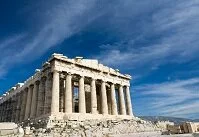Over the next thousand years architecture was continuously build, but few great monuments remain today from these early years. Olympia (900s BC) contains some ruins including the ancient Olympic venues, but no full structures. Then, in the 800s and 700s BC these styles from the Hellenistic islands to the mainland and surrounding areas began to merge into a single style (Archaic) and the birth of what is now known as Classical Greek architecture.

Parthenon in the Acropolis
Through the 600s BC Doric and Ionic styles were fully defined. The Doric order came first, followed by the Ionic, although both were similar and developed at nearly the same time, although in different regions. These two styles remained for centuries and directly led to the High Classical Period from about 450-400 BC.
The crowning achievement during the High Classical period is Athens's Acropolis, which includes the Parthenon, the Temple of Athena, and more. More than the structures, this established both religious and civic architecture as a mainstay in Greece and nearly all stone buildings from this time and centuries later were either civic or religious in nature. Other examples of High Classical architecture in Greece include numerous structures in the ancient city of Delphi, and the Temple of Apollo Epicurius in the ancient city of Bassae.
Greek Classical architecture continued to dominate the international stage through the 300s BC, during which time many more structures were built that remain in good condition today (both inside and outside of modern-day Greece). The ancient city of Epidaurus (300s BC) contains some of the best architecture from this time period, including the incredible theater along with the Temple of Asklepios. However, after this point, the Romans began to dominate the Mediterranean Sea region and Greece fell into decline for a number of years, leaving few architectural monuments.